IJCRR - 10(5), March, 2018
Pages: 07-14
Date of Publication: 15-Mar-2018
Print Article
Download XML Download PDF
Comparative Evaluation of Salivary pH Using Herbal, Conventional and Remineralizing Toothpaste: In vivo Study
Author: Palak Jindal, Sanjyot Anvay Mulay, L. Rajpurohit
Category: Healthcare
Abstract:Objective: The purpose of the study was to compare salivary pH of herbal, conventional and remineralizing toothpaste at various time intervals.
Materials and Methods: 45 study participants were selected and divided into 3 groups (15 participants in each group). Resting salivary samples were collected before brushing, immediately after brushing i.e. at 0 minutes and at intervals of 10, 30 and 60 minutes respectively, in sterile beakers and evaluated using a digital pH meter.
Results: The difference in mean salivary pH after brushing was found to be statistically significant for each of herbal, conventional and remineralizing toothpaste at different time intervals. There was a rise in pH seen in all three groups, the least being in herbal toothpaste. However, there was no significant difference in intergroup comparison of different toothpaste at various time intervals.
Conclusion: The pH of saliva increases after brushing in each of the commercially available toothpaste. Herbal toothpaste presented the least change in salivary pH after brushing.
Keywords: Herbal, Conventional, Remineralizing, Ph, Saliva
DOI: 10.7324/IJCRR.2018.1052
Full Text:
Introduction:
Despite advancements in oral disease science, dental caries continues to be a worldwide health concern affecting humans of all ages, covering over 65% of the population around the world.1 It is critical to comprehend the oral environment so as to bring down the occurrence of caries in a community. Although acid generating bacteria are the etiologic agents, dental caries has been thought of as a multifactorial disease as it is not only influenced by dietary factors but host factors as well.1,2,3 In addition, the role of saliva as a defense system against dental caries is well documented. Saliva plays an important role in optimal oral health and research proposes that salivary pH is even more critical to the development and progression of dental caries than once thought. Low salivary pH promotes the growth of aciduric bacteria which then allows the acidogenic bacteria to proliferate with the production of lactic acid, causing demineralization i.e. initial carious lesion. By controlling pH it is possible to alter the plaque biofilm, remineralize existing lesions, and perhaps prevent the disease altogether.4
Due to the widespread and regular use of toothpaste, they serve as the most effective tool for oral disease prevention and control. A variety of toothpaste is available on the commercial front these days, out of which herbal toothpaste are becoming very popular amongst the masses due to their composition of natural active ingredients and properties such as antioxidant, antiseptic, antimicrobial, and analgesic.5 Preventive remineralizing professional treatments are quite expensive, thus strategies to remineralize the initial carious lesion, as well as prevention of progression of disease, should be given significance.
So the purpose of this study was to evaluate whether herbal, conventional and remineralizing toothpaste has an influence on salivary pH and their comparison at various time intervals after brushing.
Objectives:
- To evaluate the pH of resting saliva before and after professional brushing at 0, 10, 30, and 60 minutes, with an herbal toothpaste (Dant Kanti, Patanjali).
- To evaluate the pH of resting saliva before and after professional brushing at 0, 10, 30, and 60 minutes, with a conventional toothpaste (Colgate Strong teeth).
- To evaluate the pH of resting saliva before and after professional brushing at 0, 10, 30, and 60 minutes, with a remineralizing toothpaste (Vantej, Dr. Reddys).
- To compare the pH of resting saliva before and after professional brushing at 0, 10, 30, and 60 minutes, with an herbal, conventional and remineralizing toothpaste.
- To compare the alteration of salivary pH at 0, 10, 30, and 60 minutes between that of an herbal, conventional and remineralizing toothpaste.
Methodology:
Type of study– Clinical study with randomized allocation.
Sampling technique – convenient sampling.
Sample selection
- Ethical clearance was obtained from the institutional ethics committee.
- Patients were screened from the outpatient department of Dr. D.Y. Patil Dental College and Hospital, Pimpri, Pune.
- Participants were selected as per the inclusion and exclusion criteria.
- A detailed case history was taken.
- Written consent was taken from the participants after explaining the procedure to them.
- A diet counseling of the participants was done.
Selection Criteria
Inclusion criteria
- Patients with carious teeth 3-8.
- Patients with OHI- index ranging from 1.3-3.0.
- Gender-both males and females
- Age group between 20-35 years.
- Systemically healthy patients.
- Patients with at least 28 teeth.
Exclusion criteria
- Smokers and chronic alcoholics.
- Patients on any medication within 48 hours.
- Pregnant and lactating women.
- Patients undergoing orthodontic treatment.
Sample Size
A total of 45 participants were selected and divided into three groups on the basis of different toothpaste used:
Group I Herbal toothpaste (Dant Kanti) N=15
Group II Conventional toothpaste (Colgate Strong teeth) N=15
Group III Remineralizing toothpaste (Vantej) N=15
Standardization of the saliva collection technique
- The participants did not eat or drink 2 hours before saliva sample collection which was done between 9-11 am. Saliva collected was at least 4 ml.
- The participants did not perform any physical exercise before collection.
- Resting whole saliva was collected over a period of 5 minutes.6
Method
After collection of resting saliva, the participants underwent professional brushing for 1-2 minutes per arch using a standardized quantity of toothpaste and polishing brush. The participants were then asked to rinse mouth with 20 ml of water swishing around for 20 seconds. Salivary samples were collected before brushing, immediately after brushing i.e. at 0 minutes and at intervals of 10, 30 and 60 minutes respectively, in the sterile beakers. pH was evaluated using a digital pH meter ( PNS digital pH meter).
The procedure was repeated for each group I, II, III using respective toothpaste.
Salivary pH readings were recorded, tabulated and analyzed statistically.
Statistical analysis
Repeated Measures ANOVA was used to compare the alterations in the mean salivary pH after brushing in each group. Post hoc Bonferroni’s test was used to compare the changes in mean salivary pH after brushing at various time intervals. One Way ANOVA was used to compare the mean of different groups together at various time intervals.
Results:
In the following given tables, the time intervals are denoted as:
Before brushing (bb) = 1
0 minutes = 2
10 minutes = 3
30 minutes = 4
60 minutes = 5
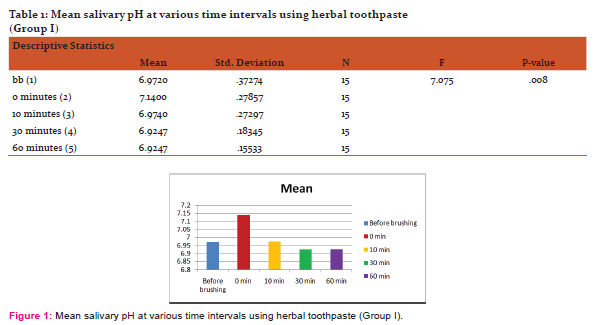
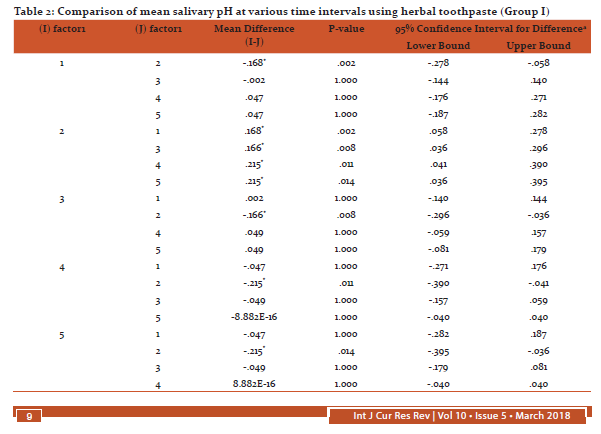


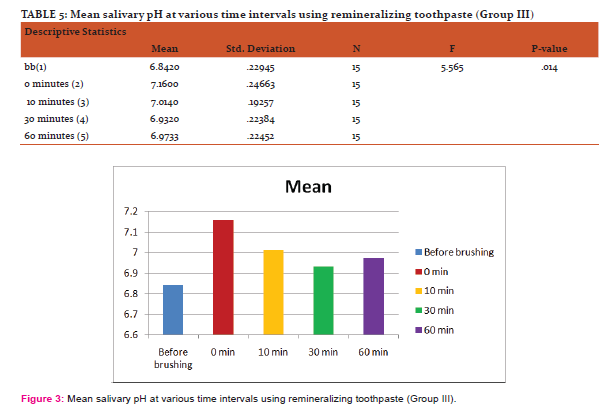
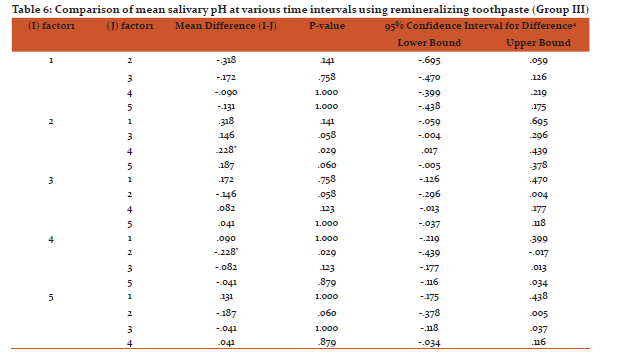
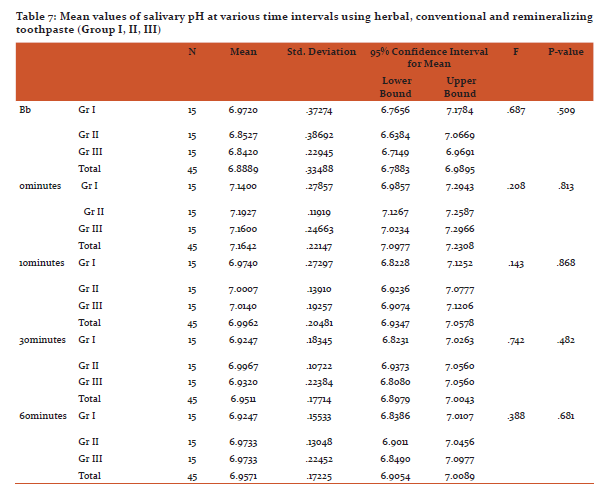
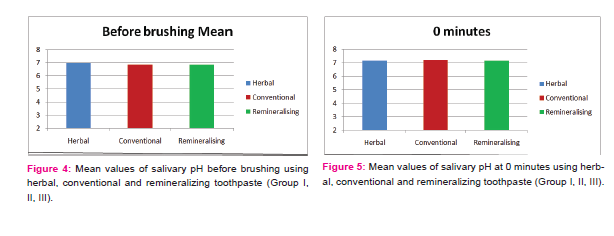


The data was found to be normally distributed and comparisons were analyzed by Repeated Measures ANOVA. Intragroup comparisons made between table 1, table 3 and table 5, showed a statistically significant difference in the mean salivary pH (P-value <0.05) at various time intervals.
Similarly, Intragroup comparisons made by using Post hoc Bonferroni’s test, in table 2, table 4 and table 6, showed a statistically significant difference in the mean salivary pH (P-value <0.05) at various time intervals.
However, One-way ANOVA in table 7, showed a non-significant difference in the mean salivary pH (P-value <0.05), when an intergroup comparison was made between the means of herbal, conventional and remineralizing toothpaste at various intervals of time.
Discussion:
The salivary pH is an important biomarker for dental caries.7 Each of this toothpaste whether herbal, conventional or remineralizing vary in their chemical composition and ingredients which may have a different influence on the salivary pH.
A significant salivary parameter affecting the carious process is the salivary pH. The flow rate of saliva increases the pH of the oral cavity. Demineralization and remineralization processes of the teeth, occurring in the oral cavity are dependent on the pH of the saliva.7 Salivary pH depends on bicarbonate content, the more basic is the pH of the saliva more is the remineralization of tooth surface by the precipitation of bicarbonate ions.
The present study was conducted to evaluate the effect of herbal, conventional, and remineralizing toothpaste on the salivary pH of the study participants at various time intervals i.e. before brushing, at 0, 10, 30, and 60 minutes respectively after brushing. The present study found that there was a significant increase in mean salivary pH after brushing with various toothpaste (P-value <0.05). Similar results were obtained in a study by Chand S et al7, Surdacka A et al8 and H.J. Florestano et al.9 However, there was no significant difference in intergroup comparison of different toothpaste at various time intervals.
In Herbal toothpaste (Group I) it was observed that at 0 minutes interval, pH rises after brushing, at 10 minutes interval the pH dropped to the same level as that of before brushing. At 30 minutes interval, there was a further drop in pH, which remained to be constant at 60 minutes interval also.
In Conventional toothpaste (Group II), it was observed that at 0 minutes interval pH rises after brushing, at 10 minutes interval there was a drop in pH which remained constant at 30 minutes interval also. Whereas at 60 minutes interval a slight drop in pH was observed. On comparison pH at 60 minutes interval was higher than the pH before brushing.
In Remineralizing toothpaste (Group III) it was observed that at 0 minutes interval pH rises after brushing, at 10 minutes interval there was a drop in pH. A further drop in pH was observed at 30 minutes interval. Whereas at 60 minutes interval there was again a rise in pH level which was not seen in group I and group II. The larger sample size is advocated to confirm the results.
Conclusion:
Under the limitations of this study, the following conclusions can be drawn.
- It can be concluded that the pH of saliva increases after brushing in each commercially available toothpaste group.
- Herbal toothpaste have no added advantage over the conventional toothpaste with respect to increasing pH
Remineralizing toothpaste has greater influence with an increase in the salivary pH for a longer time as compared to herbal and conventional toothpaste.
Conflict of Interest:
There was no conflict of interest.
Source of Funding: None
Acknowledgement:
Authors acknowledge the immense help received from the scholars whose articles are cited and included in references to this manuscript. The authors are also grateful to authors/editors/publishers of all those articles, journals and books from where the literature for this article has been reviewed and discussed.
References:
- Dwitha Animireddy, Venkata Thimma Reddy Bekkem, Pranitha Vallala, Sunil Babu Kotha, Swetha Ankireddy, Noorjahan Mohammad. Journal of Contemporary Clinical Dentistry, 2014 Jul-Sep; 5(3): 324–328.
- Loesche WJ. Role of streptococcus mutans in human dental decay. Microbial rev. 1986; 50 (4): 353-80.
- Van Nieuw Amerongen A, Bolscher JG, Veerman EC. Salivary proteins: Protective and diagnostic value in cariology? Caries Res. 2004; 38: 247–53.
- California Dental Hygienist’s Association, Winter 2010; 25(1): 9-14.
- Jacob George, Shashikant Hegde, Rajesh KS, Arun Kumar. The efficacy of a herbal- based toothpaste in the control of plaque and gingivitis. Indian Journal of Dental Research, 2009; 20(4): 480-482.
- Navin Anand Ingle, Reenu Sirohi, Navpreet Kaur, Amit Siwach. Salivary fluoride levels after tooth brushing with dentifrices containing different concentrations of fluoride. Journal of International Society of Preventive and Community Dentistry, 2014; 4(2): 129-32.
- Chand S, Gulati P, Dhingra S, Swatika. Estimating the pH of commercially available dentifrices and evaluating its effect on salivary pH after brushing. Journal of Oral Health and Community Dentistry, 2013; 7(1): 12-16.
- Surdacka A, Stopa J. The effect of xylitol toothpaste on the oral cavity environment. The Journal of Preventive Medicine, 2005; 13(1-2):98-107.
- Florestano HJ, Myron A Elliott, JE Faber Jr. The effect of citrus juices and various mouth prophylaxes on the oral flora and saliva. J Bacteriol, 1941; 41(5): 605-25.
|






 This work is licensed under a Creative Commons Attribution-NonCommercial 4.0 International License
This work is licensed under a Creative Commons Attribution-NonCommercial 4.0 International License